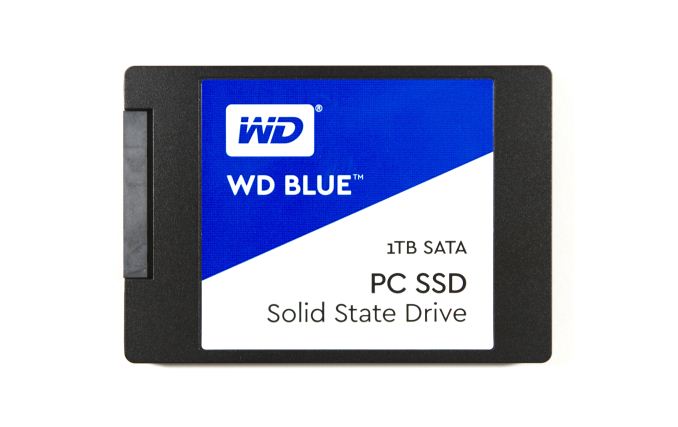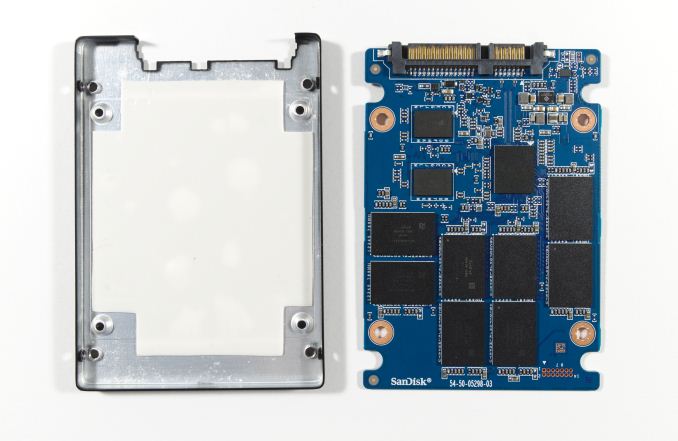The Western Digital Blue (1TB) SSD Review: WD Returns to SSDs
by Billy Tallis on October 11, 2016 8:00 AM EST- Posted in
- SSDs
- Storage
- Western Digital
- SanDisk

Five months after completing its acquisition of SanDisk, Western Digital is introducing SSDs under the WD brand for the consumer market. The WD Blue is the mainstream SATA offering and is derived from the SanDisk X400. While not exactly the first Western Digital SSD in blue, the WD Blue is the beginning of a new era for the WD brand and is an acknowledgment that SSDs are now mainstream consumer products that exist alongside or displace hard drives instead of just occupying a high-end niche.
The SanDisk X400 was announced at the beginning of this year as the new flagship of SanDisk's business/OEM client SSD family. When we reviewed it in May we were pleasantly surprised to find that it raised the bar for the performance and power efficiency of planar TLC SSDs and was a credible mid-range drive, not just an entry-level budget-oriented product. The WD Blue SSD uses the same hardware platform as the SanDisk X400, but with some changes to the firmware. Most notably, the WD Blue reserves a bit more spare area and thus has capacities of 250GB, 500GB and 1000GB where the X400 has capacities of 128GB–1024GB. There are minor differences to the performance specifications and the WD Blue has only a three year warranty compared to the X400's five years. (Though still better than the two year warranty carried by the current WD Blue hard drives.)
| Western Digital WD Blue Specifications | |||||
| Capacity | 250GB | 500GB | 1000GB | ||
| Form Factor | 2.5" 7mm SATA or M.2 2280 SATA | ||||
| Controller | Marvell 88SS1074 | ||||
| NAND | SanDisk 15nm TLC | ||||
| Sequential Read | 540 MB/s | 545 MB/s | 545 MB/s | ||
| Sequential Write | 500 MB/s | 525 MB/s | 525 MB/s | ||
| 4KB Random Read | 97k IOPS | 100k IOPS | 100k IOPS | ||
| 4KB Random Write | 79k IOPS | 80k IOPS | 80k IOPS | ||
| Average Power | 70 mW | ||||
| Max Power | 4.4 W | ||||
| Encryption | No | ||||
| Endurance (TBW) | 100 TB | 200 TB | 400 TB | ||
| Warranty | Three years | ||||
| MSRP | $79.99 | $139.99 | $299.99 | ||
All capacities of the WD Blue are available in either the 2.5" SATA form factor or as M.2 2280 cards. This continues the trend of recent mainstream SATA SSDs placing M.2 on an equal footing with the 2.5" form factor.
As a result of the increased spare area, the WD Blue has a higher write endurance rating than the SanDisk X400 and one of the highest endurance ratings of any TLC SSD. It even exceeds the rating on some capacities of the Samsung 850 Pro that comes with a 10 year warranty. Western Digital is pitching the WD Blue as suitable for heavy workloads, and even if its performance falls short of the best SATA drives it should last a very long time even when subject to a write-intensive workload.
| SSD Endurance Specifications Comparison | |||||
| Capacity | 240-256GB | 480-512GB | 960-1024GB | ||
| WD Blue | 100 TBW | 200 TBW | 400 TBW | ||
| SanDisk X400 | 80 TBW | 160 TBW | 320 TBW | ||
| OCZ Trion 150 | 60 TBW | 120 TBW | 240 TBW | ||
| OCZ VX500 | 148 TBW | 296 TBW | 592 TBW | ||
| Samsung 850 EVO | 75 TBW | 150 TBW | 150 TBW | ||
| Samsung 850 Pro | 150 TBW | 300 TBW | 300 TBW | ||
The construction of the WD Blue carries over the same metal case and plastic lid that SanDisk has been using for years. Inside our 1TB sample we find the same single-sided PCB as in the X400 and the thermal pad that covers nearly every component. The NAND is arranged in eight packages of 128GB each, while the Micron DRAM is split across two packages.
For this review the 1TB WD Blue will be compared against most of the other 1TB-class SATA drives we have tested. The current competition in the marketplace consists primarily of the preceding SanDisk X400, cheaper planar TLC SSDs such as the OCZ Trion 150, MLC SSDs that are mostly significantly more expensive, and 3D TLC SSDs such as the Samsung 850 EVO and Crucial MX300. Note that while we have already reviewed the 750GB Crucial MX300, in this review we are comparing against the 1050GB MX300 that will be covered by an upcoming review of the wider range of MX300 capacities that are now available.
| AnandTech 2015 SSD Test System | |
| CPU | Intel Core i7-4770K running at 3.5GHz (Turbo & EIST enabled, C-states disabled) |
| Motherboard | ASUS Z97 Pro (BIOS 2701) |
| Chipset | Intel Z97 |
| Memory | Corsair Vengeance DDR3-1866 2x8GB (9-10-9-27 2T) |
| Graphics | Intel HD Graphics 4600 |
| Desktop Resolution | 1920 x 1200 |
| OS | Windows 8.1 x64 |
- Thanks to Intel for the Core i7-4770K CPU
- Thanks to ASUS for the Z97 Deluxe motherboard
- Thanks to Corsair for the Vengeance 16GB DDR3-1866 DRAM kit, RM750 power supply, Carbide 200R case, and Hydro H60 CPU cooler

















75 Comments
View All Comments
Arbie - Tuesday, October 11, 2016 - link
I agree with another comment. Why is the Mushkin Reactor 1TB not in the charts for recent SSD reviews? At $230 it's cheaper than many, is MLC, and overall seems like a great buy. You reviewed it but then seem to have forgotten it.DanNeely - Tuesday, October 11, 2016 - link
I'm a bit puzzled by the performance consistency numbers here. In them the WD Blue 1TB seems to be consistently faster than the Sandisk X400 1TB before reaching steady state and about the same speed once it hits that point; but in almost all the other benches the Sandisk scores higher.Billy Tallis - Tuesday, October 11, 2016 - link
The drive is completely filled once before the random write consistency test, which runs at QD32. Most of the other IOmeter scores are averages of low queue depths, and the random write test on page 6 is limited to a 16GB test file on an otherwise empty drive. Whatever effect caused the WD Blue to have lower peak performance is more significant for the shorter test, while for the consistency test the fact that the WD Blue has more spare area to start with than the X400 is a bigger factor.kmmatney - Tuesday, October 11, 2016 - link
I bought a SanDisk Ultra II 960GB drive about a year ago for around $200, and it's still close to that price ($219 at the moment). It's the one with SLC cache - I use it in my everyday work computer, as my OS drive, and I typically run 1-2 virtual machines as well. So I push it fairly hard for a consumer SSD, and it still runs great - no complaints at all, and I'd recommend it for the price.Michael Bay - Thursday, October 13, 2016 - link
Same experience here. In a few weeks it will be a year of use for me, and if Sandisk utility is to be trusted, it`s only 1% worn.mapesdhs - Friday, October 14, 2016 - link
It's a pity the X300 is not available anymore, it had very good consistency and at one point was cheaper than many budget models.Shadowmaster625 - Tuesday, October 11, 2016 - link
It is amazing that they fit all that on one side of the board without so much as a capacitor on the back...LordConrad - Tuesday, October 11, 2016 - link
Sorry, I refuse to buy a SSD that uses TLC planar NAND.TheinsanegamerN - Tuesday, October 11, 2016 - link
why? these have higher write endurance then some MLC drives.MrCommunistGen - Tuesday, October 11, 2016 - link
That was quick - WD releasing an SSD under their own name. Sure it is a warmed over X400, but as the performance numbers indicate they didn't just slap a sticker on it... which leads to my next comment.When I read the opening of the article I was pretty excited. X400 with a bit more overprovisioning. I was expecting to see extra performance (even if only a little) along with the endurance. I guess not. Oh well.